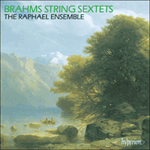
Welcome to Hyperion Records, an independent British classical label devoted to presenting high-quality recordings of music of all styles and from all periods from the twelfth century to the twenty-first.
Hyperion offers both CDs, and downloads in a number of formats. The site is also available in several languages.
Please use the dropdown buttons to set your preferred options, or use the checkbox to accept the defaults.

The following Andante is a set of variations—another ancient form much loved by Brahms and of which he was a true master. The music is wonderfully imagined for the forces available and carefully avoids textures that could be mistaken for those of the string quartet. The first variation employs the time-honoured device of increasing the sense of movement by subdivisions of the music’s pulse.
The Scherzo is both vigorous and pithy, characteristics which are unusually continued in the trio section. Its similarity to the trio of the Scherzo in Beethoven’s Fifth Symphony has not escaped comment by critics.
The final Rondo owes not a little to Schubert and was criticized by Joachim for not being forceful enough in its concluding bars. He also, not without some justice, wished that Brahms had been able to achieve greater contrast between the first and second subjects. Nevertheless it concludes a fine work, not to be dismissed lightly, and certainly not as disdainfully as did Brahms himself in a letter to Clara Schumann which accompanied the manuscript of the first three movements. In it he entreated her to ‘burn the trash’ in order not to have the bother of returning it.
from notes by Peter Lamb © 2000
L’Andante suivant est une série de variations—autre forme ancienne adorée de Brahms, qui en était un véritable maître. La musique, merveilleusement conçue pour les forces disponibles, évite soigneusement les textures qui pourraient être prises pour celles d’un quatuor à cordes. La première variation recourt au procédé, consacré par l’usage, consistant à accroître la notion de mouvement au moyen de subdivisions du rythme de la musique.
Le Scherzo est à la fois vigoureux et concis—caractéristiques qui se poursuivent, ce qui est inhabituel, dans la section en trio. Les critiques n’ont d’ailleurs pas manqué de souligner ses similitudes avec le trio du Scherzo de la Cinquième symphonie de Beethoven.
Le Rondo final, fort redevable à Schubert, fut critiqué par Joachim, qui déplorait le manque de puissance de ses mesures conclusives. Joachim souhaitait également, non sans quelque raison, que Brahms parvînt à davantage de contraste entre les premier et second sujets. Ce Rondo n’en conclut pas moins une belle œuvre, à ne pas rejeter à la légère, et certainement pas aussi dédaigneusement que Brahms le fit lui-même, dans une lettre à Clara Schumann accompagnant le manuscrit des trois premiers mouvements et implorant Clara de «brûler ces âneries», pour ne pas avoir à se donner la peine de les lui retourner.
extrait des notes rédigées par Peter Lamb © 2000
Français: Hypérion
Das anschließende Andante ist eine Folge von Variationen, eine weitere alte Form, die Brahms sehr schätzte und die er meisterhaft beherrschte. Die Musik ist wunderbar auf die vorhandenen Kräfte zugeschnitten und vermeidet sorgsam Strukturen, die man mit denen eines Streichquartetts verwechseln könnte. Die erste Variation setzt das althergebrachte Mittel ein, durch Unterteilen des Zeitmaßes der Musik das Gefühl des Vorwärtsdrangs zu verstärken.
Das Scherzo ist ebenso kraftvoll wie prägnant, und beide Merkmale werden ungewöhnlicherweise ins Trio hinübergerettet. Dessen Ähnlichkeit mit dem Trio aus dem Scherzo von Beethovens Fünfter Sinfonie ist vor Kommentaren der Kritiker nicht verschont geblieben.
Das abschließende Rondo verdankt Schubert einiges und wurde von Joachim dahingehend kritisiert, daß es in den letzten Takten nicht eindringlich genug sei. Er wünschte sich auch mit einiger Berechtigung, daß es Brahms gelungen wäre, das erste und zweite Thema deutlicher voneinander abzuheben. Nichtsdestoweniger beschließt der Satz ein eindrucksvolles Werk, das nicht einfach abgetan werden sollte, und schon gar nicht so verächtlich, wie es Brahms selbst in einem Brief an Clara Schumann tat—er legte seinem Schreiben das Manuskript der ersten drei Sätze bei und meinte, sie solle es verbrennen, um ihr die Mühe der Rücksendung zu ersparen.
aus dem Begleittext von Peter Lamb © 2000
Deutsch: Anne Steeb/Bernd Müller
 Brahms: String Sextets Brahms: String Sextets‘Glorious performances … [they] can take their place beside any of the great chamber music recordings of the past, and will continue to set stand ... ‘These are superb performances; the recording is vivid and immediate’ (The Penguin Guide to Compact Discs)» More |

